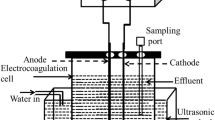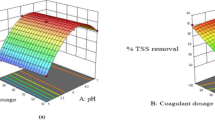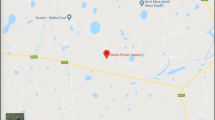Abstract
The present study aimed to investigate the feasibility of applying recovered water treatment sludge (WTS) as a low-cost coagulant using the acidification/sonification method for turbidity removal. The WTS was completely characterized by BET, XRD FTIR, and FE-SEM observation. The effects of the main variables including WTS dosage (50–250 mg/l), sedimentation time (10–50 min), initial turbidity (10–350 NTU), and pH values (5–9) have been assessed and optimized using central composite design through response surface methodology. The developed empirical model significantly predicts and supports the results. The results showed that the turbidity removal was approximately completed at pH 9, initial turbidity of 350 NTU, and sedimentation time of 10 min by applying 250 mg/l WTS. The turbidity removal at the optimum condition was 85.83%. The results of this study indicated a high potential for recycled WTS as a low-cost coagulant, which can be used in the full-scale application.









Similar content being viewed by others
References
Abidin, Z. Z., Shamsudin, N. S. M., Madehi, N., & Sobri, S. (2013). Optimisation of a method to extract the active coagulant agent from Jatropha curcas seeds for use in turbidity removal. Industrial Crops and Products, 41, 319–323.
Adams, F., & Mulaba-Bafubiandi, A. (2014). Application of rice hull ash for turbidity removal from water. Physics and Chemistry of the Earth, Parts A/B/C, 72, 73–76.
Ahmad, T., Ahmad, K., Ahad, A., & Alam, M. (2016). Characterization of water treatment sludge and its reuse as coagulant. Journal of Environmental Management, 182, 606–611.
Al-Husseini, T. R., Ghawi, A. H., & Ali, A. H. (2019). Performance of hydraulic jump rapid mixing for enhancement of turbidity removal from synthetic wastewater: A comparative study. Journal of Water Process Engineering, 30, 100590.
Almasi, A., Navazeshkha, F., & Mousavi, S. A. (2017). Biosorption of lead from aqueous solution onto Nasturtium officinale: performance and modeling. Desalination and Water Treatment, 65, 443–450. https://doi.org/10.5004/dwt.2017.20308.
Altaher, H., Tarek, E. K., & Abubeah, R. (2016). An agricultural waste as a novel coagulant aid to treat high turbid water containing humic acids. Global Nest Journal, 18(2), 279–290.
Antov, M. G., Šćiban, M. B., Prodanović, J. M., Kukić, D. V., Vasić, V. M., Đorđević, T. R., et al. (2018). Common oak (Quercus robur) acorn as a source of natural coagulants for water turbidity removal. Industrial Crops and Products, 117, 340–346.
Baghvand, A., Zand, A. D., Mehrdadi, N., & Karbassi, A. (2010). Optimizing coagulation process for low to high turbidity waters using aluminum and iron salts. American Journal of Environmental Sciences, 6(5), 442–448.
Bai, L., Wang, C., Huang, C., He, L., & Pei, Y. (2014). Reuse of drinking water treatment residuals as a substrate in constructed wetlands for sewage tertiary treatment. Ecological Engineering, 70, 295–303.
Baltakys, K., Jauberthie, R., Siauciunas, R., & Kaminskas, R. (2007). Influence of modification of SiO2 on the formation of calcium silicate hydrate. Materials Science-Poland, 25(3), 663–670.
Birjandi, N., Younesi, H., Bahramifar, N., Ghafari, S., Zinatizadeh, A. A., & Sethupathi, S. (2013). Optimization of coagulation-flocculation treatment on paper-recycling wastewater: application of response surface methodology. Journal of Environmental Science and Health, Part A, 48(12), 1573–1582.
Chen, B. H., King, P. H., & Randall, C. W. (1976). Alum recovery from representative water-treatment-plant sludges. Journal (American Water Works Association), 68, 204–207.
Davarnejad, R., Moraveji, M. K., & Havaie, M. (2018). Integral technique for evaluation and optimization of Ni(II) ions adsorption onto regenerated cellulose using response surface methodology. Arabian Journal of Chemistry, 11(3), 370–379.
Egbuna, S. O., Mbah, C. N., & Okoye, J. O. (2015). Optimal process parameters for the adsorption of methylene blue on thermally activated Enugu white clay as a local adsorbent. International Journal of Engineering Science Invention, 4(9), 32–42.
Fujiwara, M. (2011). Outline of sludge treatment and disposal at water purification plant in Japan. In: 1st Japan–Singapore workshop and symposium.
Ghafari, S., Aziz, H. A., & Bashir, M. J. (2010). The use of poly-aluminum chloride and alum for the treatment of partially stabilized leachate: A comparative study. Desalination, 257(1–3), 110–116.
Igwegbe, C. A., Mohmmadi, L., Ahmadi, S., Rahdar, A., Khadkhodaiy, D., Dehghani, R., et al. (2019). Modeling of adsorption of methylene blue dye on Ho-CaWO4 nanoparticles using response surface methodology (RSM) and artificial neural network (ANN) techniques. MethodsX, 6, 1779–1797.
Irawan, C., Liu, J., & Wu, C.-C. (2011). Removal of boron using aluminum-based water treatment residuals (Al-WTRs). Desalination, 276(1–3), 322–327.
Keeley, J., Jarvis, P., Smith, A. D., & Judd, S. J. (2016). Coagulant recovery and reuse for drinking water treatment. Water Research, 88, 502–509.
Keeley, J., Smith, A. D., Judd, S. J., & Jarvis, P. (2014). Reuse of recovered coagulants in water treatment: An investigation on the effect coagulant purity has on treatment performance. Separation and Purification Technology, 131, 69–78. https://doi.org/10.1016/j.seppur.2014.04.033.
King, P. H., Chen, B. H., & Weeks, R. K. (1975). Recovery and reuse of coagulants from treatment of water and wastewater (Vol. 77). Citeseer.
Kumar, P. S., Vaibhav, K., Rekhi, S., & Thyagarajan, A. (2016). Removal of turbidity from washing machine discharge using Strychnos potatorum seeds: Parameter optimization and mechanism prediction. Resource-Efficient Technologies, 2, S171–S176.
Liu, Y., Zheng, Y., & Wang, A. (2010). Response surface methodology for optimizing adsorption process parameters for methylene blue removal by a hydrogel composite. Adsorption Science & Technology, 28(10), 913–922.
Mohammadi-Moghaddam, F., Mahdavi, M., Hajizadeh, Y., Tashauoei, H. R., Ataeifar, H., & Ebrahimi, A. (2015). Treatment of highly turbid water by polyaluminum ferric chloride (PAFCL). Archives of Hygiene Sciences, 4(4), 208–216.
Mohammed, T. J., & Shakir, E. (2018). Effect of settling time, velocity gradient, and camp number on turbidity removal for oilfield produced water. Egyptian Journal of Petroleum, 27(1), 31–36.
Mousavi, S. A., & Ibrahim, S. (2016). Application of response surface methodology (RSM) for analyzing and modeling of nitrification process using sequencing batch reactors. Desalination and Water Treatment, 57(13), 5730–5739.
Mousavi, S. A., Mehralian, M., Khashij, M., & Parvaneh, S. (2017). Methylene Blue removal from aqueous solutions by activated carbon prepared from N. microphyllum (AC-NM): RSM analysis, isotherms and kinetic studies. Global Nest Journal, 19(4), 697–705.
Muthuraman, G., & Sasikala, S. (2014). Removal of turbidity from drinking water using natural coagulants. Journal of Industrial and Engineering Chemistry, 20(4), 1727–1731.
Nadarajan, R., Bakar, W. A., Ali, R., & Ismail, R. (2018). Photocatalytic degradation of 1, 2-dichlorobenzene using immobilized TiO2/SnO2/WO3 photocatalyst under visible light: application of response surface methodology. Arabian Journal of Chemistry, 11(1), 34–47.
Nair, A. T., & Ahammed, M. M. (2014). Coagulant recovery from water treatment plant sludge and reuse in post-treatment of UASB reactor effluent treating municipal wastewater. Environmental Science and Pollution Research, 21(17), 10407–10418.
Nayeri, D., Mousavi, S. A., & Mehrabi, A. (2019). Oxytetracycline removal from aqueous solutions using activated carbon prepared from corn stalks. Journal of Applied Research in Water and Wastewater, 6(1), 67–72.
Ndabigengesere, A., & Narasiah, K. S. (1998). Quality of water treated by coagulation using Moringa oleifera seeds. Water Research, 32(3), 781–791.
Ociński, D., Jacukowicz-Sobala, I., Mazur, P., Raczyk, J., & Kociołek-Balawejder, E. (2016). Water treatment residuals containing iron and manganese oxides for arsenic removal from water–Characterization of physicochemical properties and adsorption studies. Chemical Engineering Journal, 294, 210–221.
Orooji, N., Takdastan, A., Eslami, A., Kargari, A., & Raeesi, G. (2016). Study of the chitosan performance in conjunction with polyaluminum chloride in removing turbidity from Ahvaz water treatment plant. Desalination and Water Treatment, 57(43), 20332–20339.
Pan, J. R., Huang, C., & Lin, S. (2004). Reuse of fresh water sludge in cement making. Water Science and Technology, 50(9), 183–188.
Parsons, S., & Daniels, S. (1999). The use of recovered coagulants in wastewater treatment. Environmental Technology, 20(9), 979–986.
Parveen, M. F., Umapathy, S., Dhanalakshmi, V., & Anbarasan, R. (2013). Synthesis and characterizations of nano sized Al(OH)3 in the presence of aniline as a dispersing agent. Indian Journal of Science, 3(8), 97–101.
Pendekal, M. S., & Tegginamat, P. K. (2013). Hybrid drug delivery system for oropharyngeal, cervical and colorectal cancer–in vitro and in vivo evaluation. Saudi Pharmaceutical Journal, 21(2), 177–186.
Prakash, P., Hoskins, D., & SenGupta, A. K. (2004). Application of homogeneous and heterogeneous cation-exchange membranes in coagulant recovery from water treatment plant residuals using Donnan membrane process. Journal of Membrane Science, 237(1–2), 131–144.
Ramadan, H., & El Sayed, A. E. A. (2020). Optimization of alum recovery from water treatment sludge-case study: Samannoud water treatment plant, Egypt. Water and Environment Journal, 34, 464–473.
Ramavandi, B. (2014). Treatment of water turbidity and bacteria by using a coagulant extracted from Plantago ovata. Water Resources and Industry, 6, 36–50.
Rezaee, R., Safari, M., Ghanbari, R., Ghahramani, E., Hosseini, M., & Zandsalimi, Y. (2017). The simultaneous removal of turbidity and humic substances from water using the enhanced coagulation process. Journal of Advances in Environmental Health Research, 5(2), 85–92.
Rodríguez, N. H., Ramírez, S. M., Varela, M. T. B., Guillem, M., Puig, J., Larrotcha, E., et al. (2010). Re-use of drinking water treatment plant (DWTP) sludge: Characterization and technological behaviour of cement mortars with atomized sludge additions. Cement and Concrete Research, 40(5), 778–786. https://doi.org/10.1016/j.cemconres.2009.11.012.
Sasikala, S., & Muthuraman, G. (2017). Turbidity removal from surface water by natural coagulants and its potential application. Iranica Journal of Energy and Environment, 8(1), 61–66.
Senthil Kumar, P., Centhil, V., Kameshwari, R., Palaniyappan, M., Kalaivani, V. D., & Pavithra, K. G. (2016). Experimental study on parameter estimation and mechanism for the removal of turbidity from groundwater and synthetic water using Moringa oleifera seed powder. Desalination and Water Treatment, 57(12), 5488–5497.
Shahbazi, D., Mousavi, S. A., & Nayeri, D. (2020). Low-cost activated carbon: Characterization, decolorization, modeling, optimization and kinetics. International Journal of Environmental Science and Technology, 17, 1–12.
Treacy, J. (2019). Drinking water treatment and challenges in developing countries. In The relevance of hygiene to health in developing countries. IntechOpen.
Usefi, S., & Asadi-Ghalhari, M. (2019). Optimization of turbidity removal by coagulation and flocculation process from synthetic stone cutting wastewater. International Journal of Energy and Water Resources, 3(1), 33–41.
Xu, G. R., Yan, Z. C., Wang, Y. C., & Wang, N. (2009). Recycle of Alum recovered from water treatment sludge in chemically enhanced primary treatment. Journal of Hazardous Materials, 161(2–3), 663–669.
Yang, L., Wei, J., Zhang, Y., Wang, J., & Wang, D. (2014). Reuse of acid coagulant-recovered drinking waterworks sludge residual to remove phosphorus from wastewater. Applied Surface Science, 305, 337–346. https://doi.org/10.1016/j.apsusc.2014.03.081.
Zangeneh, H., Zinatizadeh, A. A. L., & Feyzi, M. (2016). Degradation of linear alkyl benzene using an immobilized nano tio2 photocatalytic reactor: Process analysis and modeling. CLEAN–Soil, Air, Water, 44(1), 78–88.
Zhou, Z., Yang, Y., Li, X., Wang, W., Wu, Y., Wang, C., et al. (2014). Coagulation performance and flocs characteristics of recycling pre-sonicated condensate sludge for low-turbidity surface water treatment. Separation and Purification Technology, 123, 1–8.
Acknowledgements
The authors hereby express their gratitude to Water and Wastewater Company of Kermanshah Province for financial support (Grant Number 129/95/21868) and Kermanshah University of Medical Sciences for supplying laboratory facilities.
Author information
Authors and Affiliations
Corresponding author
Additional information
Publisher's Note
Springer Nature remains neutral with regard to jurisdictional claims in published maps and institutional affiliations.
Rights and permissions
About this article
Cite this article
Nayeri, D., Mousavi, S.A. Optimization, modeling, and characterization of water treatment sludge modified by ultrasound-assisted acid activation for enhancing of turbidity removal. Environ Dev Sustain 23, 8377–8393 (2021). https://doi.org/10.1007/s10668-020-00971-z
Received:
Accepted:
Published:
Issue Date:
DOI: https://doi.org/10.1007/s10668-020-00971-z




